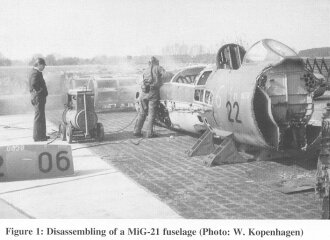| |
published in EUROAVIA News 12/1994

|
In October 1990 the German Democratic Republic joined the Federal Republic of Germany. That was also the end of the
National Peoples Army of the GDR. Only about 4.000 of 52.000 regular soldiers and three weapons systems have been
taken over by the "Bundeswehr" (German army), among them the famous MiG-29 interceptor aircraft.
But GDR Air Force owned only 24 "Fulcrums" (NATO reporting name of the MiG-29), another type was the
backbone fighter of both GDR and the other Warsaw pact air forces: the Mikoyan / Gurevich MiG-21. This airplane is
considered to be the most outstanding Soviet fighter aircraft of the 1950's.
Korean war combat analysis resulted in requirements for a lightweight fighter with highest possible air combat
performance and maneuverability and ability to operate from roughly prepared airstrips.
|
|
and under licence in India, Czechoslovakia and China. MiG-21 were produced with six different gun armaments, three
different engines, three types of ejection seats and two different radars. There are also versions without guns,
without radar, with or without blown flaps. On the surface the several versions differ in form and size of the dorsal
spine and the fin. Experts distinguish between four generations of the MiG-21 with about 20 main versions and more
than 100 subversions.
In 1990 the GDR Air Force owned about 440 airplanes, among them 189 MiG-21 of three generations in nine versions.
Because Germany ratified the "Treaty on Conventional Armed Forces in Europe" it is allowed to own only 900
combat planes, but together with the East German aircrafts the reunited Germany had 1.040 combat planes available.
Hence it was decided to destroy 140 MiG-21.
This work was done by the
|

|
"Elbe-Flugzeugwerke Dresden", that means by the same people, who were famous for their high standard
maintenance of the MiG-21 in many countries all over the world. The first disassembling took place on the 25th
September 1992 and in November 1993 the news agencies announced the destruction of the last Fishbed.
|
The MiG-21 was designed using the most advanced knowledge of aerodynamics in the middle of the 1950's and is
comparable with Lockheed "Starfighter", BAC "Lightning" and Dassault "Mirage III".
The MiG-21, in western countries better known as "Fishbed", made its maiden flight on 16th June 1956 and has
been built in greater numbers than any other aircraft of the postwar era, estimations differ between 8.000 and 18.000.
It has equipped more air forces than any other fighter in history; the current assessments range from 45 up to 50,
numbers which no western fighter can approach. "Fishbeds" have been built in both the Soviet Union
|
|
Among the 140 Fishbeds assigned for scrapping could be found 39 of the last version MiG-21bis. Much later built than
the still used "Phantoms" of the German Air Force it is said about these aircrafts by western experts that
they have nearly the same air combat performance as the F-16A. But destructing these aircrafts was not only a
technical but also a political decision.
The technology of destruction was fixed by the articles of the disarmament treaty: using a blowtorch the fuselage was
divided into three parts, the engine was removed. The wingtips were cut and the wings were taken off. This happened on
former GDR airbases. After that the large parts
|
were taken to the "Elbe Flugzeugwerke", where all equipments were removed, sorted and prepared for disposal.
Some important parts like the sight and the radar were counted by international inspectors before destructing.
The engines were taken to MTU Ludwigsfelde, which was the maintenance factory for both fighter and helicopter engines
in the GDR, where they also were disassembled and scrapped. The destruction of 140 Fishbeds cost five millions German
Marks. Only some German MiG-21 have the chance to survive in several museums all over the world.
But the fate of the NVA MiG's is not typically for hundreds of MiG-21 still being in service all over the world.
|
|
In cooperation with the Israeli firms ELTA and IAI the Romanian Air Force modernizes its MiG-21 fleet. The so called
MiG-21 2000 equipped with a new radar, head-up-display and many other improvements was shown in Paris some months ago.
China still produces a modification of the first version Fishbed fitted out with avionics from the British firm GEC
and in 1996 - 40 years after the maiden flight of the first MiG-21 prototype - the roll-out of the Super 7, a MiG-21
airframe with new avionics and air intake is planned. Last but not least at the Moscow airshow the Mikoyan design
bureau for the first time offered the MiG-21-93 upgrade that enables the MiG-21 to use the weapon systems of the
MiG-29. The first prototype equipped
|

|
with Russian and French avionics was one of the stars at ILA'94 in Berlin.
Accordingly it seems that some day the MiG-21 will be not only the most widely produced jet fighter but also the
fighter with the longest active life of any combat aircraft in history.

|

| | |